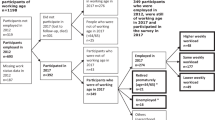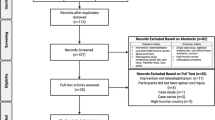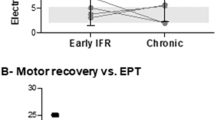Abstract
Study design:
Cross-sectional study.
Objectives:
The study aimed (a) to test the cross-validation of current one-repetition maximum (1RM) predictive equations in men with spinal cord injury (SCI); (b) to compare the current 1RM predictive equations to a newly developed equation based on the 4- to 12-repetition maximum test (4–12RM).
Setting:
SARAH Rehabilitation Hospital Network, Brasilia, Brazil.
Methods:
Forty-five men aged 28.0 years with SCI between C6 and L2 causing complete motor impairment were enrolled in the study. Volunteers were tested, in a random order, in 1RM test or 4–12RM with 2–3 interval days. Multiple regression analysis was used to generate an equation for predicting 1RM.
Results:
There were no significant differences between 1RM test and the current predictive equations. ICC values were significant and were classified as excellent for all current predictive equations. The predictive equation of Lombardi presented the best Bland–Altman results (0.5 kg and 12.8 kg for mean difference and interval range around the differences, respectively). The two created equation models for 1RM demonstrated the same and a high adjusted R2 (0.971, P<0.01), but different SEE of measured 1RM (2.88 kg or 5.4% and 2.90 kg or 5.5%).
Conclusion:
All 1RM predictive equations are accurate to assess individuals with SCI at the bench press exercise. However, the predictive equation of Lombardi presented the best associated cross-validity results. A specific 1RM prediction equation was also elaborated for individuals with SCI. The created equation should be tested in order to verify whether it presents better accuracy than the current ones.
Similar content being viewed by others
Log in or create a free account to read this content
Gain free access to this article, as well as selected content from this journal and more on nature.com
or
References
Hicks AL, Martin KA, Pelletier CA, Ditor DS, Foulon B, Wolfe DL . The effects of exercise training on physical capacity, strength, body composition and functional performance among adults with spinal cord injury: a systematic review. Spinal Cord 2011; 49: 1103–1127.
Turbanski S, Schmidtbleicher D . Effects of heavy resistance training on strength and power in upper extremities in wheelchair athletes. J Strength Cond Res 2010; 24: 8–16.
Ribeiro FN, Gentil P . The effects of resistance training intervention in the rehabilitation of patients with spinal cord injury: a literature review. Acta Fisiatr 2011; 18: 91–96.
Bar-On ZH, Nene AV . Relationship between heart rate and oxygen uptake in thoracic level paraplegics. Paraplegia 1990; 28: 87–95.
Mulroy SJ, Gronley JK, Newsam CJ, Perry J . Electromyographic activity of shoulder muscles during wheelchair propulsion by paraplegic persons. Arch Phys Med Rehabil 1996; 77: 187–193.
Perry J, Gronley JK, Newsam CJ, Reyes ML, Mulroy SJ . Electromyographic analysis of the shoulder muscles during depression transfers in subjects with low-level paraplegia. Arch Phys Med Rehabil 1996; 77: 350–355.
Cooney MM, Walker JB . Hydraulic resistance exercise benefits cardiovascular fitness of spinal cord injured. Med Sci Sports Exerc 1986; 18: 522–525.
Jacobs PL, Nash MS, Rusinowski JW . Circuit training provides cardiorespiratory and strength benefits in persons with paraplegia. Med Sci Sports Exerc 2001; 33: 711–717.
Figoni SF . Exercise responses and quadriplegia. Med Sci Sports Exerc 1993; 25: 433–441.
Wilmore JH, Costill DL, Kenney WL . Physiology of Sport and Exercise, 4th edn.Human Kinetics Publishers: Champaign, IL, USA. 2007.
Mukherjee G, Samanta A . Energy cost and locomotor performance of the low-cost arm-lever-propelled three-wheeled chair. Int J Rehabil Res 2001; 24: 245–249.
Nash MS, van de Ven I, van Elk N, Johnson BM . Effects of circuit resistance training on fitness attributes and upper-extremity pain in middle-aged men with paraplegia. Arch Phys Med Rehabil 2007; 88: 70–75.
Davies HT, Crombie IK . Getting to grips with systematic reviews and meta-analyses. Hosp Med 1998; 59: 955–958.
Hicks AL, Martin KA, Ditor DS, Latimer AE, Craven C, Bugaresti J et al. Long-term exercise training in persons with spinal cord injury: effects on strength, arm ergometry performance and psychological well-being. Spinal Cord 2003; 41: 34–43.
Mojtahedi MC, Valentine RJ, Evans EM . Body composition assessment in athletes with spinal cord injury: comparison of field methods with dual-energy X-ray absorptiometry. Spinal Cord 2009; 47: 698–704.
Maggioni M, Bertoli S, Margonato V, Merati G, Veicsteinas A, Testolin G . Body composition assessment in spinal cord injury subjects. Acta Diabetol 2003; 40 (Suppl 1): S183–S186.
Jones LM, Goulding A, Gerrard DF . DEXA: a practical and accurate tool to demonstrate total and regional bone loss, lean tissue loss and fat mass gain in paraplegia. Spinal Cord 1998; 36: 637–640.
Gorgey AS, Shepherd C . Skeletal muscle hypertrophy and decreased intramuscular fat after unilateral resistance training in spinal cord injury: case report. J Spinal Cord Med 2010; 33: 90–95.
Kim PS, Mayhew JL, Peterson DF . A modified YMCA bench press test as a predictor of 1 repetition maximum bench press strength. J Strength Cond Res 2002; 16: 440–445.
Ratamess NA, Alvar BA, Evetoch TK, Housh TJ, Kibler WB, Kraemer WJ et al. American College of Sports Medicine position stand. progression models in resistance training for healthy adults. Med Sci Sports Exerc 2009; 41: 687–708.
Garber CE, Blissmer B, Deschenes MR, Franklin BA, Lamonte MJ, Lee IM et al. American College of Sports Medicine position stand. Quantity and quality of exercise for developing and maintaining cardiorespiratory, musculoskeletal, and neuromotor fitness in apparently healthy adults: guidance for prescribing exercise. Med Sci Sports Exerc 2011; 43: 1334–1359.
Dwyer GB, Davis SE, Pire NI, Thompson WR . ACSM's Health-Related Physical Fitness Assessment Manual, 4th edn. Lippincott Williams & Wilkins: Philadelphia, PA, USA. 2010.
Thompson WR, Gordon NF, Pescatello LS . ACSM's Guidelines for Exercise Testing and Prescription, 8th edn. Lippincott Williams & Wilkins: Philadelphia, PA, USA. 2009.
Brown LE, Weir JP . ASEP Procedures Recommendation I: accurate assessment of muscular strength and power. J Exerc Physiol 2001; 4: 1–21.
Abadie BR, Altorfer GL, Schuler PB . Does a regression equation to predict maximal strength in untrained lifters remain valid when the subjects are technique trained? J Strength Cond Res 1999; 13: 259.
Schwingel PA, Porto YC, Dias MC, Moreira MM, Zoppi CC . Predicting one repetition maximum equations accuracy in paralympic rowers with motor disabilities. J Strength Cond Res 2009; 23: 1045–1050.
Reynolds JM, Gordon TJ, Robergs RA . Prediction of one repetition maximum strength from multiple repetition maximum testing and anthropometry. J Strength Cond Res 2006; 20: 584.
Lacio ML, Damasceno VO, Vianna JM, Lima JRP, Reis VM, Brito JP et al. Precision of 1-RM prediction equations in non-competitive subjects performing strength training. Motricidade 2010; 6: 31–37.
Dohoney P, Chromiak JA, Lemire D, Abadie B, Kovacs C . Prediction of one repetition maximum (1-RM) strength from a 4-6 RM and a 7-10 RM submaximal strength test in healthy young adult males. J Exerc Physiol. Online 2002; 5: 54–59.
Simpson SR, Rozenek R, Garhammer J, Lacourse M, Storer T . Comparison of one repetition maximums between free weight and universal machine exercises. J Strength Cond Res 1997; 11: 103–106.
LeSuer DA, McCormick JH, Mayhew JL, Wasserstein RL, Arnold MD . The accuracy of prediction equations for estimating 1-RM performance in the bench press, squat, and deadlift. J Strength Cond Res 1997; 11: 211.
Knutzen KM, Brilla LR, Caine D . Validity of 1RM prediction equations for older adults. J Strength Cond Res 1999; 13: 242–246.
Epley B . Poundage Chart. Boyd Epley Workout. Body Enterprises: Lincoln, NE, USA. 1985.
Lombardi VP . Beginning Weight Training: the Safe and Effective Way. WC Brown: Dubuque, IA, USA. 1989.
O'Connor R, Simmons J, O'Shea P . Weight Training Today. West Publishing: St Paul, MN, USA. 1989.
Mayhew JL, Ball TE, Arnold MD, Bowen JC . Relative muscular endurance performance as a predictor of bench press strength in college men and women. J Strength Cond Res 1992; 6: 200.
Brzycki M . Strength testing—predicting a one-rep max from reps-to-fatigue. J Phys Educ Rec Dan 1993; 64: 88–90.
Baechle TR, Groves BR . Weight Training: Steps to Success 2nd ednHuman Kinetics Publishers: Champaign, IL, USA. 1998.
Kirshblum SC, Burns SP, Biering-Sorensen F, Donovan W, Graves DE, Jha A et al. International standards for neurological classification of spinal cord injury (revised 2011). J Spinal Cord Med 2011; 34: 535–546.
Kirshblum SC, Waring W, Biering-Sorensen F, Burns SP, Johansen M, Schmidt-Read M et al. Reference for the 2011 revision of the International Standards for Neurological Classification of Spinal Cord Injury. J Spinal Cord Med 2011; 34: 547–554.
Ribeiro FN, Lopes GH . Body composition modifications in people with chronic spinal cord injury after supervised physical activity. J Spinal Cord Med 2011; 34: 586–593.
Bulbulian R, Johnson RE, Gruber JJ, Darabos B . Body composition in paraplegic male athletes. Med Sci Sports Exerc 1987; 19: 195–201.
Ribeiro FN, Lopes GH . Analysis of body composition values in men with different spinal cord injury levels. Fisioter Mov 2013; 26: 743–751.
Spungen AM, Bauman WA, Wang J, Pierson RN Jr . Measurement of body fat in individuals with tetraplegia: a comparison of eight clinical methods. Paraplegia 1995; 33: 402–408.
Dias RMR, Cyrino ES, Salvador EP, Caldeira LFS, Nakamura FY, Papst RR et al. Influence of familiarization process on muscular strength assessment in 1-RM tests. Rev Bras Med Esporte 2005; 11: 34–38.
Cicchetti DV . Guidelines, criteria, and rules of thumb for evaluating normed and standardized assessment instruments in psychology. Psychol Assessment 1994; 6: 284.
Whisenant MJ, Panton LB, East WB, Broeder CE . Validation of submaximal prediction equations for the 1 repetition maximum bench press test on a group of collegiate football players. J Strength Cond Res 2003; 17: 221–227.
Nascimento MAd, Cyrino ES, Nakamura FY, Romanzini M, Pianca HJC, Queiróga MR . Validation of the Brzycki equation for the estimation of 1-RM in the bench press. Rev Bras Med Esporte 2007; 13: 47–50.
Menêses A, Santana F, Soares A, Souza B, Souza D, Santos M et al. Validity of one repetition maximum predictive equations vary according to the exercise performed in trained young adults. Rev Bras Ativ Fis Sau 2013; 18: 95–104.
Becque DM, Pick J . Validity of predicting 1RM and % 1RM in weight-trained and untrained males. Med Sci Sports Exerc 1995; 27: S210.
Braith RW, Graves JE, Leggett SH, Pollock ML . Effect of training on the relationship between maximal and submaximal strength. Med Sci Sports Exerc 1993; 25: 132–138.
Acknowledgements
We thank the Physical Education staff of Sarah Rehabilitation Hospital Network who provided us with support and assistance for the development of this research. We certify that no party has a direct interest in the results of the research supporting this article or has or will confer benefit on us or on any organization with which we are associated.
Author information
Authors and Affiliations
Corresponding author
Ethics declarations
Competing interests
The authors declare no conflict of interest.
Rights and permissions
About this article
Cite this article
Ribeiro Neto, F., Guanais, P., Dornelas, E. et al. Validity of one-repetition maximum predictive equations in men with spinal cord injury. Spinal Cord 55, 950–956 (2017). https://doi.org/10.1038/sc.2017.49
Received:
Revised:
Accepted:
Published:
Issue date:
DOI: https://doi.org/10.1038/sc.2017.49
This article is cited by
-
Isometric maximal voluntary contraction test: a proposal of a specific protocol for high-level H3 handcyclists athletes
Sport Sciences for Health (2025)
-
Development and deployment of an at-home strength and conditioning program to support a phase I trial in persons with chronic spinal cord injury
Spinal Cord (2021)
-
A pragmatic randomized controlled trial testing the effects of the international scientific SCI exercise guidelines on SCI chronic pain: protocol for the EPIC-SCI trial
Spinal Cord (2020)



